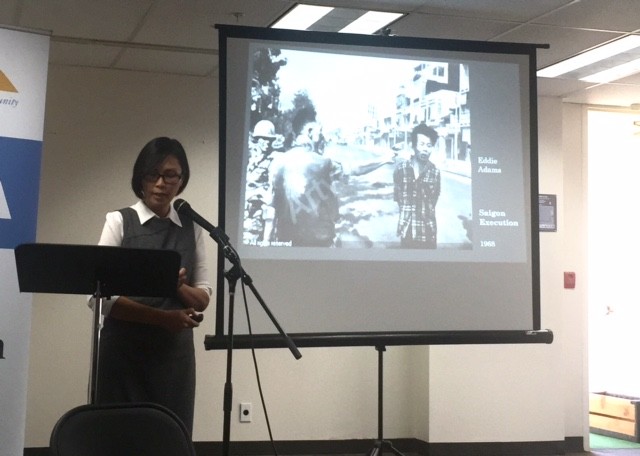
For the 40th anniversary of the end of the Vietnam War, the Vietnamese American Arts & Letters Association (VAALA) held an event yesterday at the VAALA Cultural Center called “To Remember,” which aimed to invoke Vietnamese-American history of the war through memorials, photographic images, and poetry. The event consisted of a poetry reading and lectures addressing the silences that continue to occupy Vietnamese-American homes regarding the past.
]
“I feel a lot of emotions as I stand here,” said speaker Yen Le Espirtu, professor and former Chair of the Department of Ethnic Studies at the University of California, San Diego. “I've given a lot of talks, but this is the first time in front of a large Vietnamese community.”
Professor Espirtu shared a chapter of her latest book, Body Counts: The Vietnam War and Militarized Refuge(es), where she argued that Vietnamese-Americans have been using Internet memorials–that is, websites about South Vietnamese war experiences created by first-generation Vietnamese-Americans–to write their histories into the American landscape. Internet memorials, Professor Espirtu argued, are attempts to counter the erasure of South Vietnamese history in remembrance of the war.
Professor Espirtu added that preserving Vietnamese memories of the war is also a matter of refugees opening up to the second generation. “The first generation goes to coffee shops and talks about their history to each other,” she said. “But they don't talk about it their children.”
In the poetry portion of the event, Cara Le–a community organizer, teacher, writer, and Asian-American studies grad student–addressed the silences in her home by reading from her collection of poems that revolved around her mother's personal life called “the Labor of Longing.”
“Why are you asking me about the past–who wants to know?” Le read from her poem “April 1975, Part III” as her mother. “I've created a cabinet of curiosities…embellishing my mother's story to make it proper for display,” Le reflected afterward. “I shouldn't have to fill all the silences with words. What I need is quiet and a time to be still. I need a photograph to hold.”
The last speaker of the night was Nguyen-Vo Thu-Huong, associate professor of Asian languages and culture and Asian American studies at UCLA. Professor Nguyen-Vo argued that historical photographs of the Vietnam War are fraught with contestation. As an example, she put up “Saigon Execution,” the famous photograph by Eddie Adams of a South Vietnamese officer about to execute a Viet Cong, on the projection screen. “The image is re-cropped and relit several times to leave out more and more of the context until the killing takes place in a tight composition,” Professor Nguyen-Vo said.
The Vietnamese community will have to continually work hard to preserve their stories, but at least for now, works like Cara Le's “April 1975, Part I” will contribute to the narrative:
There was no time to cry, no window to look out of. The helicopter engine fired and the force of the blade caused the air to reverberate, louder than all their heartbeats combined.
Email: kh****@oc******.com.
Follow OC Weekly on Twitter @ocweekly or on Facebook!

